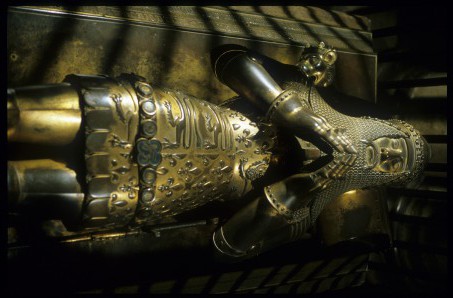Keeping with the same theme as last week for the first part of the blog, my joint enterprise again involves this Centre, the partner organisation being Canterbury Cathedral Archives and Library, and especially the cathedral librarian Karen Brayshaw. In addition, and because this is a much larger enterprise, it is great to be able to report the Medieval Canterbury Weekend has secured sponsorship from Canterbury- and Kent-based organisations. Consequently those organising the Weekend are exceedingly grateful to Kent Archaeological Society and the Friends of Canterbury Archaeological Trust, and to mark this appreciation members of these two organisations will be able to purchase tickets to events at a concessionary rate. Furthermore, we would like to thank The William and Edith Oldham Charitable Trust and Peter Hobbs for their support. It is great to receive such assistance not least because the organisers are hoping to raise funds towards postgraduate bursaries in medieval studies and to offer something towards several iconic medieval buildings in Canterbury; that is those that feature in the programme of events.
I know I have reported on this Weekend before but after a great deal of hard work by Matthew Crockatt on the Centre’s web pages and members of the booking team under Arts & Culture, we are finally there! This means it is now possible to see details of all 22 events that are due to take place between 1 and 3 April 2016: who will be speaking, on what, where and when, and where, when and what visits are available. As you will see, we have grouped the events under 5 headings which we hope will be a useful guide, but that’s all and the ethos behind the Weekend is very much one of people choosing ‘a pick-and-mix’ bag – just as you would in a sweet shop. So, please, whether you are already interested in medieval history or just curious, do have a look and hopefully I’ll see some of you next April. The easiest way to see details is using:
http://www.canterbury.ac.uk/medieval-canterbury
however you can also call the Arts & Culture box office on 01227 782994 or if you are local to Canterbury drop into Augustine House where you will find the box office in the foyer.
The second part of this blog concerns a fascinating lecture I went to this evening as the final talk in the Ancestors windows series in the cathedral’s chapter house and archives. As some of you may remember, I reported on the exhibition of the Ancestors stained glass windows a few weeks ago. This time I want to mention Dr Rachel Koopmans’ discoveries regarding both the Ancestors windows and the Becket Miracle windows. She believes there are many similarities in terms of planning and glazing between the two series, and, perhaps most interesting of all, that they indicate a change of plan by the glaziers part way through installation of the glass in both series. As a result the Ancestors and the Miracle windows required ‘a patch’ as she calls it – the need to find more subjects/windows because the Trinity Chapel was made longer than had been originally planned. For the Ancestors this meant bringing in Christ’s ancestors mentioned in Matthew’s Gospel but not in Luke’s, which had provided the basic format; and for the Miracle windows drawing on the miracle narratives of William of Canterbury rather than just keeping to the better known narratives of Benedict of Peterborough.
This new research provides evidence of a far more coherent pattern among the various Miracle windows, the narrative and chronology of Becket’s life and miracles moving around the ambulatory from north-west to south-west via the east end. In part Dr Koopmans’ analysis rests on her re-evaluating the miracle narratives displayed in the windows, including changing the accepted ideas about which miracles are represented. This close assessment not only highlights her considerable scholarship but excitingly has implications regarding ideas of audience and use of the windows within and beyond the cathedral community. I am, therefore, looking forward to her further research and thereafter the book and articles that I am sure will follow.
 Centre for Kent History and Heritage
Centre for Kent History and Heritage Sheila Sweetinburgh
Sheila Sweetinburgh 336
336



Comment on “Medieval Canterbury Weekend”